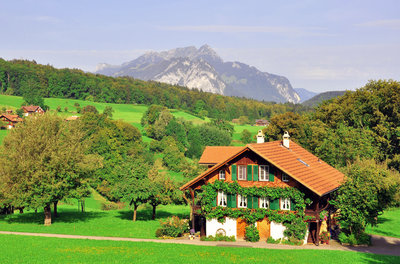16/06/2021 | Buy a property
How Ownership By Floor works: share and thousandths calculation
In Ownership By Floor, the share of each of the co-owners, in other words the share of charges that he will have to pay to the administration of the ownership by floor, is expressed in thousandths. These thousandths represent the value of each floor unit in relation to the total value of the building. The number of thousandths therefore determines the share that the co-owner will have to pay for the share areas and their maintenance, the structure of the building, the land on which the building is established. The thousandths also make it possible to calculate the quorum* during a general meeting so that people can deliberate. In the event of damage to the building, it is also on the basis of thousandths that the insurance will pay compensation to the co-owners. At the end of this article, we will explain what a quorum is and what are the different majorities required at a general meeting.
Reminder of what ownership by floor is
Ownership by floor is a special form of co-ownership where each co-owner has an exclusive right to use and fit out certain interior parts of a building.
In an Ownership By Floor, a distinction is made between the private parts over which the co-owner has an exclusive right of use (his apartment, the non-load-bearing interior walls, the front door, etc.) and the common parts, of which the members of the Ownership By Floor are co-owners (the plot on which the building is built, the load-bearing walls, the roof, the elevator, the green spaces, etc.)
Each floor unit corresponds to a number of thousandths. Remember that a floor unit corresponds to all the premises (the apartment itself but also the cellar, the closed box, the attic) over which the owner has exclusive enjoyment and use rights. The thousandths are used to distribute the charges between the co-owners (the share to be paid on the entire co-ownership) and the number of votes each has to make decisions at general meetings.
What is taken into account when calculating thousandsth?
The calculations are entrusted to an expert who will determine, for each floor unit, the areas and their weighting, select the rating criteria and the importance given to each of the criteria while taking into account any easements. Each co-owner’s share is then entered in the Land Register.
The calculation of thousandths does not depend solely on the area of the apartment. Thus two apartments of the same area will not necessarily have the same number of thousandths, the share will therefore be different and the charges higher or lower.
Among the criteria taken into account are:
- The surface in square meters of the units subject to an exclusive right (in other words units of which you are the exclusive owner), but also the position of the apartment in the building, its orientation, the view, possible nuisances, etc. For the same surface area, accommodation on the top floor with a view will represent more thousandths than an apartment on the first floor with a view of the car park or the motorway.
- The surface area of ancillary premises such as an attic, a cellar, an individual garage, etc.
- The surface area of the units subject to a right of use, such as a parking space, for example.
In order to meet the evaluation criteria, the USPI (Swiss Union of Real Estate Professionnals) issued recommendations on the calculation of shares (document in French).
Is it possible to request a modification of the number of thousandsth?
Changing the number of thousandths, and therefore of shares, is a long procedure that must be validated by all the co-owners at a general meeting. It can be requested by an owner, or more, in the event of an error when setting up the Ownership By Floor or in the event of an expansion of the building with the constitution of new lots.
* What is the quorum?Any co-owner general meeting begins with the calculation of the quorum. In order for the general meeting to be able to deliberate and take decisions, there must be one. The latter is reached if at least half of the co-owners are present or represented (thanks to a power of attorney given to another co-owner or to the administrator of the Ownership By Floor) and if they represent at least half of the value of the shares. Depending on the decisions to be made, several types of majority may be required. Simple majority: this is the majority usually required. A decision is adopted as soon as it is accepted by more than half of the co-owners present or represented. Abstentions and zero votes are taken into account. Each member of the owners’ assembly has only one vote, even if he owns several lots. Double majority: it requires the majority of co-owners present or represented at the meeting. This majority must therefore represent more than half of the total value of the shares. A double majority is necessary for the most important acts of administration. Absolute majority: it requires the majority of all co-owners, including those who are absent. Unanimity: it is only required for important acts which cannot be imposed on an owner without infringing his right to property. Unanimity particularly concerns major work, such as the construction of a swimming pool, and therefore requires the consent of all co-owners. |
- Aargau properties for sale
- Appenzell Outer Rhodes properties for sale
- Appenzell Innerrhoden properties for sale
- Basel-Landschaft properties for sale
- Basel-City properties for sale
- Bern properties for sale
- Fribourg properties for sale
- Geneva properties for sale
- Glarus properties for sale
- Graubünden properties for sale
- Jura properties for sale
- Lucerne properties for sale
- Neuchâtel properties for sale
- Nidwalden properties for sale
- Obwalden properties for sale
- Saint Gallen properties for sale
- Schaffhausen properties for sale
- Schwyz properties for sale
- Solothurn properties for sale
- Thurgau properties for sale
- Ticino properties for sale
- Uri properties for sale
- Valais properties for sale
- Vaud properties for sale
- Zug properties for sale
- Zurich properties for sale
- Liechtenstein properties for sale
- Zürich properties for sale
- Geneva properties for sale
- Basel properties for sale
- Lausanne properties for sale
- Bern properties for sale
- Winterthur properties for sale
- Lucerne properties for sale
- St. Gallen properties for sale
- Lugano properties for sale
- Biel/Bienne properties for sale
- Thun properties for sale
- Bellinzona properties for sale
- Köniz properties for sale
- Fribourg properties for sale
- La Chaux-de-Fonds properties for sale
- Schaffhausen properties for sale
- Chur properties for sale
- Vernier properties for sale
- Uster properties for sale
- Sion properties for sale
- Neuchâtel properties for sale
- Carouge GE properties for sale
- Emmen properties for sale
- Zug properties for sale
- Yverdon-les-Bains properties for sale
- Dübendorf properties for sale
- Aargau rental properties
- Appenzell Outer Rhodes rental properties
- Appenzell Innerrhoden rental properties
- Basel-Landschaft rental properties
- Basel-City rental properties
- Bern rental properties
- Fribourg rental properties
- Geneva rental properties
- Glarus rental properties
- Graubünden rental properties
- Jura rental properties
- Lucerne rental properties
- Neuchâtel rental properties
- Nidwalden rental properties
- Obwalden rental properties
- Saint Gallen rental properties
- Schaffhausen rental properties
- Schwyz rental properties
- Solothurn rental properties
- Thurgau rental properties
- Ticino rental properties
- Uri rental properties
- Valais rental properties
- Vaud rental properties
- Zug rental properties
- Zurich rental properties
- Liechtenstein rental properties
- Zürich rental properties
- Geneva rental properties
- Basel rental properties
- Lausanne rental properties
- Bern rental properties
- Winterthur rental properties
- Lucerne rental properties
- St. Gallen rental properties
- Lugano rental properties
- Biel/Bienne rental properties
- Thun rental properties
- Bellinzona rental properties
- Köniz rental properties
- Fribourg rental properties
- La Chaux-de-Fonds rental properties
- Schaffhausen rental properties
- Chur rental properties
- Vernier rental properties
- Uster rental properties
- Sion rental properties
- Neuchâtel rental properties
- Carouge GE rental properties
- Emmen rental properties
- Zug rental properties
- Yverdon-les-Bains rental properties
- Dübendorf rental properties


